|
fashion: feature
 Samedis à la mode
Samedis à la mode
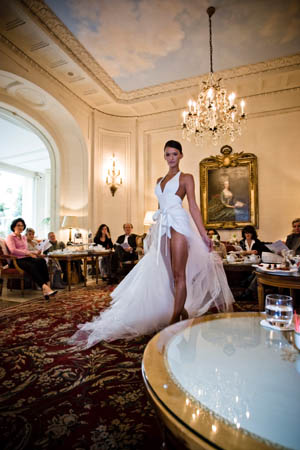
Christophe-Alexandre Docquin
Keren Chiaroni finds the best way to indulge Parisian
style, without the stress of fashion week, at the 8th
arrondissement’s Hotel
Bristol
PARIS FASHION SHOWS, and the hype
surrounding them, are legendary. So is the exclusivity of the guest
list, unless you are amongst the “most wanted” of society’s famous
and fashionable. Covered assiduously by reporters and photographers,
runway shows are major media events, even though access to the shows
remains the privilege of a minority.
Meanwhile, in the heart of Paris’s 8th arrondissement,
in the gilded elegance of the Hotel Bristol, fashion shows of a
different kind of exclusivity take place on select Saturdays throughout
the year. The exclusive nature of these shows is determined quite
simply by the fact that they are unique, and that the hotel’s architecture
only allows a certain number of guests to be seated comfortably
at one time. If you miss out, it will not be because of who you
know or don’t know, but because of the very democratic rule that
if you don’t call in advance, then someone else may take your seat
(in which case, you may have to postpone your pleasure for another
Saturday).
In the luxuriously appointed hotel bar, you get to
enjoy all the glamour of haute couture and the excitement of seeing
new collections, while being made to feel you actually belong in
this rarefied world, as exquisite dainties are served for your refreshment,
with tea or coffee, by charmingly attentive staff. The confections
are specially prepared by the hotel’s chef, Laurent Jeannin, and
designed to complement the vision of the couturier du jour, who
may be a young unknown artist with a career to make, or, equally,
a mega-star like Lacroix or Galliano. As you lift fine china to
your lips, the models brush past your chair, to the accompaniment
of music and the click and flash of a single, professional photographer.
It is 4 o’clock in the afternoon. The great romance of tea and cakes
at the Bristol has begun.
Such a love match between haute couture and high tea
was arguably anticipated in late nineteenth-century Paris.
By 1853, Japan had opened her doors to trade with the
west, and by the end of the century, Europe was enjoying a steady
flow of ‘green gold’, as tea was then called, from Japan as well
as China and India.
Tea supplied the aromatic high note in the growing
taste for all things oriental, fed by the world trade fairs in Paris
and London, whose displays acted like enormous shop windows to the
artefacts and accessories of the east. Fine porcelain, silks, and
kimono-inspired gowns became especially desirable commodities in
fashionable society.
Eventually these three—tea, fine porcelain, and the
graceful lines from the kimono—would unite in the wonderfully seductive
concoction known as the tea-gown, a garment to be worn while sipping
tea from China whose pearly surface reflected the sheen of the gowns
themselves. Perfect for receiving a lover or relaxing with friends
in the salon, le tea-gown was composed of loose, flowing
fabrics that achieved at once a daring revelation of the female
form and a degree of unprecedented comfort. The un-corseted tea-gown
was thus erotic and practical, luxurious and comfortable.
If these gowns were fashionable all over Europe, it
is the French author Proust, who acknowledged and poeticized their
elegant sensuality in his novel, In Search of Lost Time.
As Valerie Steele points out, it is when Odette wears ‘a tea-gown
of pink silk, which left her neck and arms bare’, that Swann begins
to truly fall in love with her. It should not surprise us that in
this masterpiece of twentieth-century literature, detailed descriptions
of clothes play their part in philosophical reflections on time,
memory, mortality and art. Particularly since the author of these
reflections lived and died in, or near, the heart of Paris, and
was accustomed to frequent just such gatherings as the Hotel Bristol
offers its clients today.
The French have always known how to associate sensuality
with practicality, and philosophical discussion with an enjoyment
of life. This is why the Bristol’s fashion high teas seem to me
to be a peculiarly French phenomenon, even though it is to the British
that we owe the terms high tea and le 5 o’clock. And
why it is in Paris, not London, that we find an old established
tea-house like Mariage Frères dressing its staff in white
tie and tails during winter, and stone-coloured linen suits during
the summer, as they serve discerning clients their measure of green
gold.
Easy cultural clichés aside, the fashion high
teas at the Bristol today are not just charmingly French. They are
fashion shows with a difference, whose ethos and vision seem to
me to be unique in a world so often perceived as frivolous and ruthless.
The difference is endemic to the very nature of the event as reflected
in the way the roles of management, designer and guests (i.e. members
of the public) are defined and have developed since the shows’ inception
in 2002.
First, it must be said that the management, in the
form of the Hotel Bristol itself, has a world-class reputation as
a hotel offering outstanding service at all levels of hospitality.
The Institutional Investor elected le Bristol Paris as the ‘world’s best hotel’ in 2008, and this is consistent with the reputation
it has built up over a number of years, since its official opening,
under Hippolyte Jamet, in 1925. (Prior to the creation of the current
hotel, the site of the hotel’s winter restaurant was occupied by
a theatre built by the Count of Castellane, society leader and patron
of the arts under the Second Empire.) The site of the present hotel
at 112 rue du Faubourg Saint-Honoré ensures an easy association
with fashion (all the mainstream designers have boutiques in the
area). But the idea of directly combining fashion with high tea
at the hotel was the brainchild in 2002 of Mme Gabrielle Hirn, former
director of the hotel’s marketing department.
Add
to Del.icio.us | Digg
it | Add
to Facebook
|
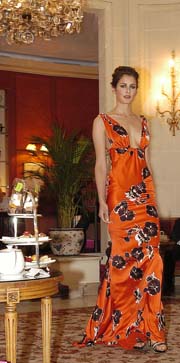
Emanuel Ungaro
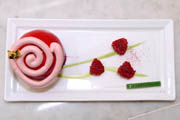
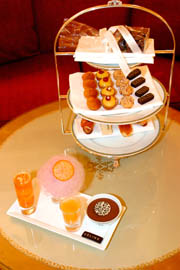
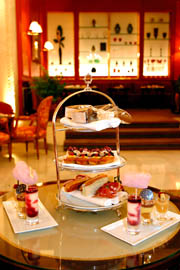
Complementing the high teas at Ungaro, Céline and Chloé.
The French have always known how to associate sensuality
with practicality, and philosophical discussion with an enjoyment
of life. This is why the Bristol’s fashion high teas seem to me
to be a peculiarly French phenomenon, even though it is to the British
that we owe the terms high tea and le 5 o’clock
|

